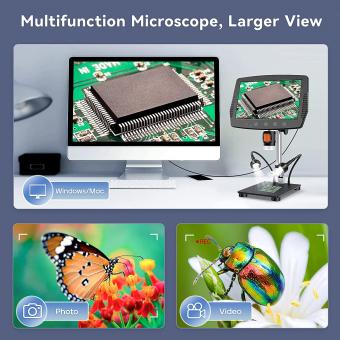Are Atoms Visible Under Electron Microscope?
Yes, atoms are visible under an electron microscope due to the high resolution and magnification capabilities of the instrument.
1、 - Electron Microscope

As of now, atoms are not directly visible under a standard electron microscope. The resolution of a typical electron microscope is limited by the wavelength of the electrons used, which is on the order of picometers. This means that while electron microscopes can provide extremely high-resolution images of atomic structures, they do not have the capability to directly visualize individual atoms.
However, recent advancements in electron microscopy techniques, such as aberration-corrected electron microscopy and atomic-resolution electron energy-loss spectroscopy, have pushed the boundaries of what can be resolved with electron microscopes. These techniques have enabled researchers to directly visualize individual atoms within a material, providing unprecedented insights into atomic structures and behaviors.
It's important to note that while these advancements have significantly improved the resolution of electron microscopes, there are still limitations to the direct visualization of atoms. The ability to see atoms under an electron microscope depends on various factors such as the type of material being studied, the imaging conditions, and the specific techniques being employed.
In summary, while atoms are not traditionally visible under a standard electron microscope, recent advancements in electron microscopy techniques have brought us closer to directly visualizing individual atoms within materials. These advancements continue to expand the capabilities of electron microscopy and offer new opportunities for understanding the atomic-scale world.
2、 - Atomic Structure

Yes, atoms are visible under an electron microscope. The development of electron microscopy has allowed scientists to directly observe individual atoms and their arrangements within materials. This has been a significant advancement in the field of nanotechnology and materials science.
The latest point of view on this topic is that with the advancement of aberration-corrected electron microscopy, it is now possible to not only visualize individual atoms but also to distinguish between different elements within a material. This level of resolution has opened up new possibilities for studying the structure-property relationships of materials at the atomic scale.
Furthermore, the development of techniques such as atomic-resolution electron tomography has enabled three-dimensional imaging of atomic structures, providing even more detailed insights into the arrangement of atoms within materials.
It's important to note that while electron microscopy has provided unprecedented views of atomic structures, there are still limitations in terms of imaging biological samples and the potential for sample damage from the electron beam. However, ongoing research and technological developments continue to push the boundaries of what is possible with electron microscopy, offering new opportunities for understanding and manipulating the atomic world.
3、 - Electron Scattering

"are atoms visible under electron microscope" - Electron Scattering
The visibility of atoms under an electron microscope depends on the technique used for imaging. In traditional transmission electron microscopy (TEM), atoms are not directly visible due to the limitations of electron scattering. The wavelength of electrons used in TEM is much smaller than the size of an atom, leading to significant electron scattering and making individual atoms difficult to resolve.
However, recent advancements in electron microscopy techniques, such as aberration-corrected TEM and scanning transmission electron microscopy (STEM), have enabled the visualization of individual atoms. These techniques utilize advanced electron optics and detectors to improve resolution and contrast, allowing for the direct imaging of atomic structures in materials.
Furthermore, the development of techniques like atomic resolution electron energy-loss spectroscopy (EELS) and electron diffraction has provided additional methods for studying atomic structures and chemical compositions at the atomic scale.
Overall, while traditional electron microscopy techniques may not directly visualize atoms due to electron scattering, modern advancements have made it possible to observe individual atoms and their arrangements in materials, providing valuable insights into the atomic-scale properties of various substances.
4、 - Resolution Limit

The resolution limit of an electron microscope refers to the smallest distance between two points that can be distinguished in an image. The resolution of an electron microscope is determined by the wavelength of the electrons used to create the image. The shorter the wavelength, the higher the resolution.
Regarding the question "are atoms visible under electron microscope", the answer depends on the specific type of electron microscope and its resolution capabilities. Traditional transmission electron microscopes (TEM) have a resolution limit that is typically not sufficient to directly visualize individual atoms. However, advancements in electron microscopy technology, such as aberration-corrected TEM and scanning transmission electron microscopy (STEM), have pushed the resolution to the point where individual atoms can be resolved under certain conditions.
In recent years, there have been significant advancements in electron microscopy techniques, leading to the direct visualization of individual atoms in materials. These advancements have been made possible by improvements in electron optics, detector technology, and data processing methods. As a result, researchers are now able to routinely image atomic structures and even observe atomic-scale dynamics in real time.
In summary, while traditional electron microscopes may not have the resolution to directly visualize atoms, the latest advancements in electron microscopy technology have made it possible to directly observe individual atoms under certain conditions. These developments have opened up new opportunities for studying materials at the atomic scale and have significantly expanded the capabilities of electron microscopy in scientific research and nanotechnology.



































